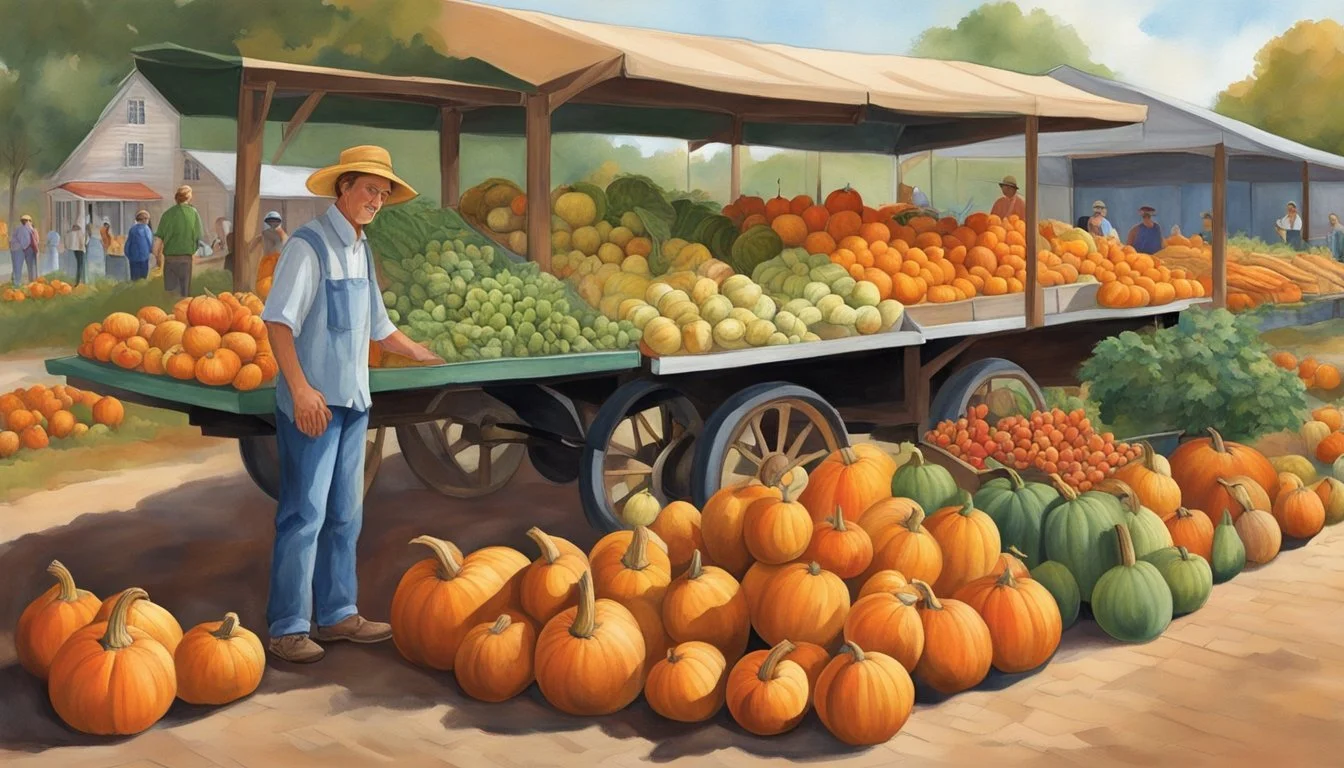South Carolina Seasonal Fruit & Vegetables in October
A Guide to Autumn Harvest
This Article is Part of our South Carolina Seasonal Fruit & Veg Calendar
In the diverse agricultural landscape of South Carolina, October ushers in a bountiful harvest season marked by a variety of fruits and vegetables. As the vibrant foliage paints a picturesque setting, local farmers and gardeners collect the rewards of a season's careful cultivation. The state's temperate climate allows for an extended growing season, and the transition into fall brings with it an array of produce that is both fresh and flavorful.
Seasonal fruits that reach their peak in October include blackberries (how long do blackberries last?), which become sweeter and less tart the longer they stay on the bush. They are joined by the last of the blueberries, rounding off their season. Vegetables take on a prominent role during this month, with a shift towards squashes such as spaghetti, buttercup, and acorn varieties, which are all harvested during this time. Leafy greens like kale (What wine goes well with kale?) and collard greens (how long do collard greens last?) thrive in the cooler weather, offering a nutritional boost to fall dishes.
South Carolina's October harvest is reflective of a broader commitment to local and seasonal eating. Certified SC Grown, a program promoting state-grown products, emphasizes the importance of choosing local and fresh ingredients. This initiative supports the idea that eating seasonally not only provides the freshest taste but also supports the local economy and reduces environmental impact. As such, October stands as a celebration of South Carolina's rich agricultural heritage and its delicious, seasonal offerings.
Seasonal Produce Overview
October in South Carolina is a vibrant time for harvesting a variety of fruits and vegetables. Local markets and farms offer fresh and flavorful produce that is at its peak during the fall season.
Fruits in Season
Apples: A staple of the season, a variety of apples such as Red Delicious, Empire, and Granny Smith are harvested throughout October.
Grapes: Fall is the time for grape harvesting, ensuring they are juicy and ripe.
Pears: With their soft texture, pears are another seasonal fruit to look for in October.
Vegetables in Season
Pumpkins: Synonymous with autumn, pumpkins are not only for decoration but also for eating.
Broccoli (how long does broccoli last?): This nutritious vegetable is best from October through April.
Cabbage: It's the right time for cabbage, which thrives in the cooler weather of October.
Sweet Potatoes (What wine goes well with sweet potatoes?): Harvested in the fall, sweet potatoes are a versatile ingredient in many dishes.
Kale and Greens: Leafy greens such as kale are abundant and packed with nutrients during the fall season.
Fall Harvesting
October in South Carolina marks a time when farmers and gardeners are actively harvesting a variety of fall produce. They gather hearty vegetables and sweet fruits, which often feature at local farmers markets.
Harvest Techniques
For root vegetables such as carrots and beets, the harvesting process involves checking the soil moisture before loosening the soil around the produce. Harvesters should be cautious not to damage the produce during extraction. The area's winter squash, like acorn and spaghetti squash, are ready when the rind is hard. These varieties are cut from the vine, leaving a bit of stem attached to extend storage life.
Storage and Preservation
Storage: Root vegetables are best stored in cool, humid environments, often in bins with damp sand to maintain freshness. Winter squash can be kept in a cool, dry place, and if cured properly, many can last throughout the winter.
Preservation: To preserve these harvests, methods like canning, freezing, and drying are common. Squash, for instance, can be roasted in an oven before being puréed and frozen. Root vegetables may be blanched and frozen, ensuring they retain their flavor and texture.
By employing proper techniques, South Carolina's fall produce, including the sweet fruits and hearty vegetables of the season, can be enjoyed well into the colder months.
Health Benefits
October harvests in South Carolina present a bounty of fruits and vegetables that are not just flavorsome but are packed with substantial health benefits. These seasonal offerings are rich in essential nutrients that promote overall well-being.
Nutritional Content
The fruits and vegetables available in South Carolina during October are characterized by their high nutritional content. They provide a variety of vitamins, minerals, and antioxidants essential for a healthy diet.
Leafy Greens: These vegetables are typically high in fiber, iron, and vitamins A, C, and K. Kale and spinach are nutrient-dense options that can significantly contribute to one's daily nutrient requirements.
Pumpkins: Loaded with vitamin A, pumpkins support eye health and immune function. They are also a good source of fiber, which aids in digestion.
Fruits such as apples and pears that ripen in October contain vitamin C and fiber. Cranberries, another seasonal fruit, are rich in antioxidants.
Incorporating into Diet
Incorporating these seasonal foods into one's diet can be both enjoyable and advantageous.
Cooking: Roasting or steaming vegetables like broccoli and Brussels sprouts helps maintain their nutritional profile and enhances their natural flavors.
Salads: Fresh leafy greens can form the base of nutrient-rich salads while adding crunch and texture.
Fruits: They can be eaten raw, which is both convenient and ensures the preservation of their vitamins and fiber.
Eating foods that are in season ensures they are at their peak of freshness and nutrient content, and incorporating these foods into one's diet supports health and can be done in a variety of delicious ways.
Local Farming Practices
Local farming practices in South Carolina reflect a year-round dedication to producing a variety of fresh, seasonal produce. These practices emphasize sustainability and community impact, ensuring a robust farm-to-table culture.
Sustainable Agriculture
In South Carolina, local farms often employ sustainable agriculture techniques to grow seasonal produce. These methods include:
Crop Rotation: Farmers use crop rotation to maintain soil health and prevent pest cycles, which is essential for year-round production.
Water Conservation: Efficient irrigation systems are utilized to conserve water while providing adequate moisture to crops.
Integrated Pest Management (IPM): IPM strategies reduce the need for chemical pesticides, resulting in produce that is healthier for consumers and the environment.
These practices contribute to the availability of a diverse array of fruits and vegetables at farmers markets and support the farm-to-table movement throughout the state.
Community Impact
Local farms in South Carolina are integral to community engagement and economic stability. They:
Boost Local Economy: Farmers markets allow growers to sell directly to consumers, which keeps the economic benefits within the community.
Enhance Food Security: By providing fresh and accessible produce year-round, local farms aid in combating food deserts.
Educational Opportunities: Farms often host school field trips and community workshops, fostering an understanding of sustainable farming practices and the importance of seasonal produce.
Through these efforts, South Carolina's local farms not only nourish but also educate and enrich their communities, ensuring a sustainable future for the state's agriculture.
Culinary Uses
October in South Carolina brings a bounty of seasonal fruits and vegetables, offering vibrant flavors and diverse culinary possibilities. Chefs and home cooks alike take advantage of this harvest in their kitchens.
Seasonal Recipes
One can utilize pumpkin and squash in an array of recipes. Pumpkin soup with a hint of nutmeg showcases the creamy texture of this gourd, while roasted acorn or butternut squash (how long does butternut squash last?) can be a sweet and savory side dish. Apples from South Carolina orchards lend themselves to both sweet and savory applications. Baked apples stuffed with cinnamon, sugar, and butter make for a comforting dessert, while adding apples to pork dishes provides a delightful contrast of flavors.
Fruit/Vegetable Seasonal Recipe Pumpkin Pumpkin Soup Squash Roasted Squash Apples Baked Apples
Sweet corn, another October staple, can be transformed into rich corn chowders or used in fresh salads that bring brightness to any meal.
Food Pairings
The harvest also offers an opportunity for creative food pairings. Pumpkin can be paired with spices such as cinnamon, cloves (how long do cloves last?), and ginger, enhancing its natural flavor profile. In salads, the sweetness of roasted squash complements the bitterness of leafy greens like arugula (how long does arugula last?), tying together the varied tastes of the season. Apples, versatile for both cooking and baking, pair wonderfully with caramel in desserts, or with sharp cheeses in savory dishes.
Pumpkin: spices (cinnamon, cloves, ginger)
Squash: leafy greens (arugula, spinach)
Apples: caramel (for desserts), sharp cheeses (for savory plates)
Culinary uses extend across a spectrum from roasting and baking to raw preparations, each method bringing out unique characteristics of these October delights.
Buying Guide
Where to Buy
When shopping for seasonal fruits and vegetables in South Carolina in October, one should begin at local farmers markets. Markets showcase a variety of fresh and locally grown produce, ensuring one supports the local economy while obtaining items at peak freshness.
What to Look For
Fruits
When choosing fruits such as blackberries:
Appearance: Look for plump, deeply colored berries without signs of drying or shriveling.
Texture: Berries should be firm, but not too hard.
Color: A deep, dark purple to almost black hue indicates ripeness.
Vegetables
For vegetables such as broccoli, cabbage, and kale:
Color: Vegetables should have vibrant, rich colors without any yellowing or brown spots.
Texture: Leaves and stems should feel firm and crisp.
Size: Typically, smaller heads of broccoli and cabbage are more tender.
Storage Tips
Produce Storage Method Blackberries Refrigerate in a single layer on a paper towel. Broccoli Keep in a plastic bag in the refrigerator. Cabbage Store in a cool, moist area for up to two weeks. Kale Keep in the fridge, unwashed, in an airtight bag.
Taking note of these pointers ensures one selects the best quality produce for enjoying the richness of South Carolina’s October bounty. Remember, fresh, local produce not only supports regional agriculture but also provides nutritional benefits and superior flavor.
Month-by-Month Guide to Produce
As the fall season unfolds in South Carolina, the agricultural calendar presents a bounty of produce. Residents and visitors alike can relish the harvests of both warm and cool weather crops during this transitional period.
What's Available in September
In September, South Carolina's fields yield a variety of fruits and vegetables reaching their peak. Consumers can find the last of the summer produce like peaches and tomatoes, alongside the beginnings of autumn's offerings.
Pumpkins: Starting to appear in late September, pumpkins become a symbol of the fall season.
Apples: Varieties of apples are harvested, ranging from tart Granny Smiths to sweet Red Delicious.
Greens: Various greens such as kale and spinach thrive in the cooler temperatures.
Sweet Potatoes: Highly nutritious and versatile, sweet potatoes are harvested.
What to Expect in November
By November, the produce selection shifts firmly into those crops that flourish in colder weather.
Apples: Continues to be available, with late-season varieties reaching the market.
Winter Squash: Including butternuts, acorns, and more exotic types, winter squash is a staple in seasonal dishes.
Greens: The variety expands to include collards and mustard greens, hearty choices for cold days.
Sweet Potatoes: Continue to be available, perfect for traditional holiday recipes.








